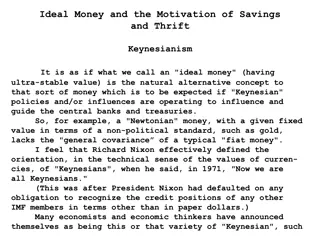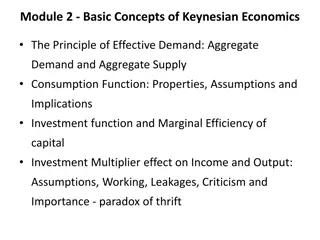Understanding Keynesian Consumption and Savings Functions in Macroeconomics
Keynesian Consumption Function relates total consumption to national income, with stable characteristics like MPC and APC. Savings Function shows the relationship between savings and income, highlighting the Marginal Propensity to Save and Average Propensity to Save. Both functions are essential concepts in analyzing economic behavior.
Download Presentation

Please find below an Image/Link to download the presentation.
The content on the website is provided AS IS for your information and personal use only. It may not be sold, licensed, or shared on other websites without obtaining consent from the author. Download presentation by click this link. If you encounter any issues during the download, it is possible that the publisher has removed the file from their server.
E N D
Presentation Transcript
COURSE: B.Sc. (PROGRAMME) IN ECONOMICS PAPER NAME MACROECONOMICS-I TOPIC-KEYNESIAN CONSUMPTION FUNCTION AND SAVINGS FUNCTION YEAR- FIRST SEMESTER- 2 SESSION- 2020-2021 DATE OF LECTURE : 15/06/2021 PREPARED BY DR. KAMALIKA CHAKRABORTY ASSISTANT PROFESSOR (DEPARTMENT OF ECONOMICS) KHATRA ADIBASI MAHAVIDYALAYA, BANKURA,WEST BENGAL
Definition of Keynesian Consumption Function: Keynesian consumption function, is an economic formula that shows the functional relationship between total consumption and gross national income. Characteristics of Keynesian Consumption Function: (1) Aggregate real consumption expenditure is a stable function of real income. (2) The marginal propensity to consume (MPC) or the slope of the consumption function defined as dc/dY must lie between zero and one i.e. 0 < MPC < 1. (3) The average propensity to consume (APC) or the proportion of income spent on consumption defined as C/Y decreases as income increases. When the average propensity to consume (APC) falls, the marginal propensity to consume (MPC) must be lower than the APC.
Characteristics of Keynesian Consumption Function (contd.): (4) The marginal propensity to consume (MPC) itself probably decreases or remains constant as income increases. The consumption function formula is C=a+bY where: C is the total consumption. a is the basic consumption. b is MPC. Y is income.
Definition of Keynesian Savings Function: Keynesian savings function, is an economic formula that shows the functional relationship between total savings and gross national income. Characteristics of Keynesian Savings Function: 1. Saving is a stable function of income. 2 .Saving varies directly with income. 3. The rate of increase in saving is less than the rate of increase in income.
Keynesian Savings Function S = Y C = Y (a + bY) [... C = a + bY] or S = a + (1 b)Y [0< (l-b) < l] Savings function has a negative intercept indicated by a and positive intercept denoted by 1-b. (1-b) is called the Marginal Propensity to Save or MPS. MPS is the change in savings due to change in income. MPS = S / Y The value of MPS is always less than one. APS is the proportion of income devoted to savings. It is obtained by dividing total saving by total income, i.e.,

























